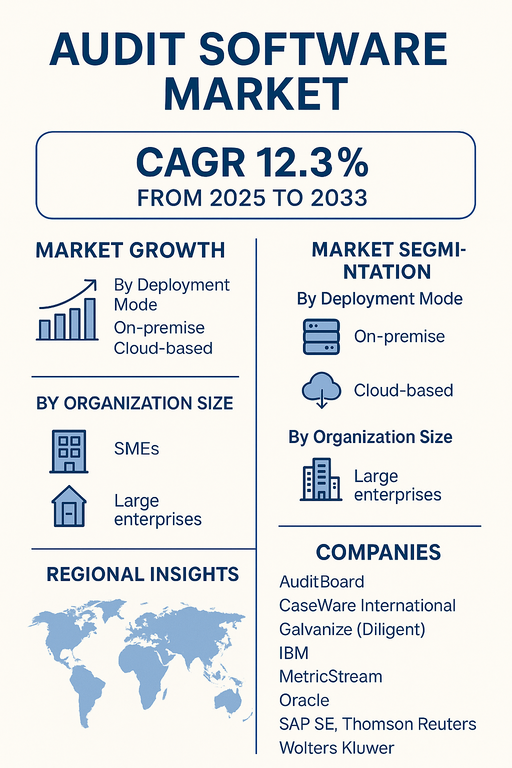The global audit software market is projected to grow at a CAGR of 12.3% from 2025 to 2033, driven by the increasing need for automation, enhanced regulatory compliance, and streamlined audit processes. Audit software solutions provide a range of tools to optimize internal audits, financial audits, and compliance checks, offering enhanced data management, reporting, and analytics capabilities. As businesses face complex regulatory environments and escalating data volumes, the demand for efficient audit software solutions to manage risks, ensure transparency, and improve operational efficiency is rising across industries.

Growth in Regulatory Compliance and Automation Adoption
The increasing complexity of global regulations, coupled with the growing emphasis on data security and corporate governance, is pushing organizations to adopt advanced audit solutions. Audit software automates manual tasks, improves audit accuracy, and speeds up processes, allowing firms to meet regulatory requirements more effectively. Automation is also reducing human error and boosting efficiency in tracking compliance, risk management, and internal controls. As a result, the demand for software solutions capable of integrating data analytics, AI, and machine learning is expanding, further driving market growth.
Challenges in Integration and Customization Costs
Despite the rapid growth, audit software adoption faces challenges in terms of integration with existing enterprise resource planning (ERP) systems and customization costs. Many organizations, especially small and medium enterprises (SMEs), find it difficult to justify the high upfront costs associated with these solutions, along with the need for tailored configurations that fit their specific auditing needs. Additionally, training and upskilling of staff to effectively use advanced software platforms can lead to added expenses. The complexity of integrating audit software into legacy systems and overcoming data silos also poses challenges for large enterprises.
Market Segmentation by Deployment Mode
The audit software market is primarily segmented into on-premise and cloud-based deployment modes. In 2024, cloud-based audit software dominated the market, driven by its scalability, cost-effectiveness, and the increasing shift towards cloud-based infrastructure in businesses worldwide. Cloud solutions offer flexible, remote access to audit tools, enabling users to collaborate seamlessly across locations. On-premise solutions, while still prevalent in certain regions and industries, are gradually being replaced by cloud-based alternatives due to the increasing preference for lower maintenance costs and enhanced accessibility.
Market Segmentation by Organization Size
The audit software market is also segmented by organization size, including SMEs and large enterprises. In 2024, large enterprises held the dominant market share, as they tend to have more complex auditing needs, larger data volumes, and more stringent compliance requirements. These organizations benefit from the robust features and customization options offered by audit software providers. However, the demand from SMEs is growing rapidly, as more small and medium-sized businesses recognize the need for automation and digital solutions to streamline their audit processes. As affordability and ease of integration improve, SMEs are increasingly adopting cloud-based audit software solutions to manage their internal auditing processes.
Regional Insights
In 2024, North America led the global audit software market, with the U.S. being the largest consumer of audit software solutions due to the high demand for compliance with Sarbanes-Oxley and other financial reporting standards. The region’s sophisticated financial infrastructure and a growing need for efficient audit tools to streamline financial reporting and risk management processes are key drivers. Europe followed, with the UK, Germany, and France leading the adoption of audit software, driven by regulatory requirements such as the EU’s GDPR and local compliance mandates. The Asia Pacific region is witnessing rapid growth, particularly in China and India, as companies undergo digital transformation and demand more efficient solutions to meet evolving auditing requirements.
Competitive Landscape
The audit software market in 2024 was characterized by a mix of established multinational software providers and niche, specialized companies offering tailored solutions. Leading players like Audit Board, CaseWare International, Galvanize (Diligent), and IBM dominated the market with comprehensive audit software platforms that cater to large enterprises. Companies such as MetricStream, Oracle, SAP SE, Thomson Reuters, Wolters Kluwer, and Workiva also maintained strong market positions, providing a wide range of audit tools and services aimed at automating compliance, risk management, and internal auditing processes. Smaller, emerging companies are gaining traction by offering innovative and cost-effective solutions tailored to SMEs and industries with specific regulatory needs, further diversifying the competitive landscape.
Historical & Forecast Period
This study report represents analysis of each segment from 2023 to 2033 considering 2024 as the base year. Compounded Annual Growth Rate (CAGR) for each of the respective segments estimated for the forecast period of 2025 to 2033.
The current report comprises of quantitative market estimations for each micro market for every geographical region and qualitative market analysis such as micro and macro environment analysis, market trends, competitive intelligence, segment analysis, porters five force model, top winning strategies, top investment markets, emerging trends and technological analysis, case studies, strategic conclusions and recommendations and other key market insights.
Research Methodology
The complete research study was conducted in three phases, namely: secondary research, primary research, and expert panel review. key data point that enables the estimation of Audit Software market are as follows:
Market forecast was performed through proprietary software that analyzes various qualitative and quantitative factors. Growth rate and CAGR were estimated through intensive secondary and primary research. Data triangulation across various data points provides accuracy across various analyzed market segments in the report. Application of both top down and bottom-up approach for validation of market estimation assures logical, methodical and mathematical consistency of the quantitative data.
| ATTRIBUTE | DETAILS |
|---|---|
| Research Period | 2023-2033 |
| Base Year | 2024 |
| Forecast Period | 2025-2033 |
| Historical Year | 2023 |
| Unit | USD Million |
| Segmentation | |
Component
| |
Deployment Mode
| |
Organization Size
| |
Application
| |
Industry Vertical
| |
|
Region Segment (2023-2033; US$ Million)
|
Key questions answered in this report